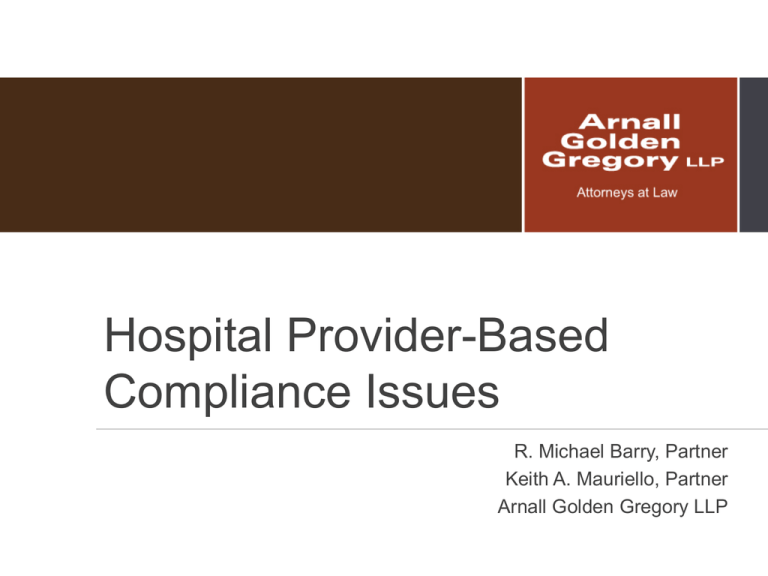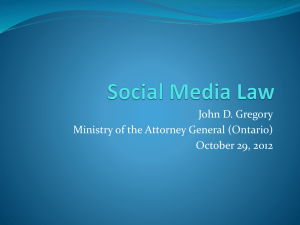
Hospital Provider-Based
Compliance Issues
R. Michael Barry, Partner
Keith A. Mauriello, Partner
Arnall Golden Gregory LLP
Introduction
Why are we talking about provider-based
issues?
– Background and Current Posture
Overview of provider-based regulations
Diligence and compliance efforts
What should you be looking for when there is a
transaction involving provider-based issues
© 2014. Arnall Golden Gregory LLP
2
Provider-Based Rules – The
Background and Current Posture
Treat subordinate facility for Medicare payment as either:
– Part of the hospital (provider-based), or
– Freestanding
Payment
– Higher reimbursement amounts (including a technical and a
professional fee) than a non-facility based service
– The hospital fee under APPS (the APC payment) is more than
would be paid if the services were furnished in a standard clinic
setting
– Beneficiary obligations are also higher – coinsurance /
deductible in a hospital setting
Coverage
– Qualifying as provider-based is required for coverage of most
services provided in hospital outpatient departments
© 2014. Arnall Golden Gregory LLP
3
Provider-Based Rules – The
Background and Current Posture
Current compliance efforts/audit coverage?
HHS OIG Work Plan (FY 2014)
Compliance
– Failure to satisfy provider-based
requirements could lead to False Claims Act
allegations
© 2014. Arnall Golden Gregory LLP
4
Provider-Based Rules – FY 2014 HHS
OIG Work Plan
Impact of provider-based status on Medicare billing
Policies and Practices. We will determine the impact of subordinate
facilities in hospitals billing Medicare as being hospital based (provider
based) and the extent to which such facilities meet CMS’s criteria.
Context—Provider-based status allows a subordinate facility to bill as part
of the main provider. Provider-based status can result in additional
Medicare payments for services furnished at provider-based facilities and
may increase beneficiaries’ coinsurance liabilities.
In 2011, the Medicare Payment Advisory Commission (MedPAC)
expressed concerns about the financial incentives presented by providerbased status and stated that Medicare should seek to pay similar amounts
for similar services. (OEI; 04-12-00380; 04-12-00381; expected issue date:
FY 2014; work in progress)
© 2014. Arnall Golden Gregory LLP
5
Provider-Based Rules – FY 2014 HHS
OIG Work Plan
Comparison of provider-based and free-standing clinics (new)
Policies and Practices. We will review and compare Medicare
payments for physician office visits in provider-based clinics and
free-standing clinics to determine the difference in payments made
to the clinics for similar procedures and assess the potential impact
on the Medicare program of hospitals‘ claiming provider-based
status for such facilities.
Context—Provider-based facilities often receive higher payments
for some services than do freestanding clinics. The requirements to
be met for a facility to be treated as a provider-based facility are at
42 CFR § 413.65(d). (OAS; W-00-14-35724; expected issue date:
FY 2014; new start)
© 2014. Arnall Golden Gregory LLP
6
Provider-Based Rules – The Rules
Regulations found at 42 C.F.R. § 413.65
Program Memorandum (Intermediaries)
Transmittal A-03-030 (April 18, 2003)
Provider-based rules apply for purposes
of both Medicare and Medicaid program
payments
© 2014. Arnall Golden Gregory LLP
7
Provider-Based Rules – The Rules
Where do the Provider Based Rules
Apply?
– On campus of hospital
– Off campus of hospital
– Multi-campus facilities
© 2014. Arnall Golden Gregory LLP
8
Provider-Based Rules – The Rules
How is “campus” defined?
– Physical area immediately adjacent to provider’s main
building
– Other areas and structures that are not strictly contiguous
to the main buildings but are located within 250 yards of
the main buildings
Encompass not only institutions that are located in selfcontained, well defined settings, but other locations
where there may be a group of buildings that function
as a campus but are not strictly contiguous and may
even be crossed by public streets
– Other areas determined on an individual basis by CMS
RO
© 2014. Arnall Golden Gregory LLP
9
Provider-Based Rules – The Rules
More Key Definitions
– Provider: A hospital, critical access hospital, skilled nursing facility, compressive
outpatient rehab facility, home health agency, hospice
– Main Provider: A Provider that either creates or acquires ownership of another
entity to deliver additional healthcare services under its name, ownership and
financial and administrative control.
– Provider-Based Entity: A provider of health care services that is either created
by or acquired by a Main Provider for the purpose of furnishing health care
services of a different type from those of the main provider under the ownership
and administrative and financial control of the Main Provider.
– Department of the Hospital: A facility or organization that is created by or
acquired by a Main Provider for the purpose of furnishing health care services of
the same type as those furnished by the Main Provider, under the name,
ownership and administrative and financial control of the Main Provider.
– Provider Based Status: Provider Based Entity or Department of the Hospital that
complies with the Provider-Based Requirements.
© 2014. Arnall Golden Gregory LLP
10
Provider-Based Rules – The Rules
What Standards are applicable to both locations? (and how is each applied
in “real life”?)
– Licensure – operated under same license
– Clinical integration
Professional staff have clinical privileges at main provider
CMS reads COPs and provider-based rules to require a
single, cohesive medical staff (thus, separate medical staffs
likely doesn’t work)
Monitoring and oversight by and reporting relationship to main
provider (same as any other department)
Medical staff committees at main provider are responsible for
medical activities
Medical records and inpatient/outpatient services are integrated
Unified retrieval system for medical records – how does that
work for paper records?
© 2014. Arnall Golden Gregory LLP
11
Provider-Based Rules – The Rules
Standards applicable to both locations (cont’d)
– Financial integration – fully integrated with main provider financial
system
– Public awareness
CMS requires that the provider-based facility be “clearly identified”
as part of the main provider
DBA/signage of facility represents to the public and other payers
that the location is part of the main provider (not just affiliated)
CMS has indicated that advertisements that only show the
facility to be part of or affiliated with the main provider’s
network or healthcare system are not sufficient
When patients enter provider-based facility, they should be aware
that they are entering the main provider and are billed accordingly
© 2014. Arnall Golden Gregory LLP
12
Provider-Based Rules – The Rules
Standards applicable to both locations (cont’d)
– Other Obligations for hospital outpatient department and hospital-based
entities
EMTALA (on-campus, off-campus plus dedicated ED)
Physician services must be billed with correct site-of-service
Comply with hospital’s provider agreement
No discrimination
Hospital outpatient departments must treat all Medicare patients for
billing purposes as hospital outpatients (can’t treat some as
physician office patients)
For patients subsequently admitted to hospital as inpatient,
payments for services are subject to payment window rules
Notice of co-insurance liability
Hospital outpatient departments must meet applicable hospital
health and safety rules, including LSC
© 2014. Arnall Golden Gregory LLP
13
Provider-Based Rules – The Rules
When providing care at an Off-Campus facility, must provide prior
written notice to beneficiary that s/he will incur an insurance liability
for an outpatient visit to the hospital as well as for the physician
service
– Set forth the amount of the beneficiary’s financial liability OR
– An explanation that the beneficiary will incur a coinsurance
liability that s/he would not incur if the facility were not hospitalbased
An estimate based upon typical or average charges
A statement that the patient’s actual liability will depend upon
the actual services furnished
– Plain English
– Timing will vary based upon patient’s condition (e.g.,
unconscious, unable to read, etc.)
© 2014. Arnall Golden Gregory LLP
14
Provider-Based Rules – The Rules
What Standards apply to off-campus only?
– Operation and control under the main
provider
100% owned by main provider (no JV)
Same governing body
Common organizational documents
Main provider has final responsibility for
administrative decisions
© 2014. Arnall Golden Gregory LLP
15
Provider-Based Rules – The Rules
Standards applicable to off-campus (cont’d)
– Administration and Supervision
Facility is under direct supervision of main provider
Same monitoring and oversight
Administrative functions are integrated (billing,
records, HR, payroll, employee benefits, salary
structure, purchasing services)
Note use of leased employees – some CMS
officials have questioned how one could show
integration without being directly employed?
© 2014. Arnall Golden Gregory LLP
16
Provider-Based Rules – The Rules
Standards applicable to off-campus (cont’d)
– Administration and Supervision (cont’d)
Things to do: review the list of provider based
departments, facilities and services delivered at
each location
review hospital privileges
review service agreements to make sure that
the meet the supervision requirements
Supervision requirements apply only to hospital
outpatient services; NOT inpatient services
© 2014. Arnall Golden Gregory LLP
17
Provider-Based Rules – The Rules
Standards applicable to off-campus (cont’d)
– Location
EMTALA obligations do not apply to off campus if no dedicated ED
35-mile radius of main campus
Has DSH greater than 11.75% and (i) is owned or operated by state
or local government, (ii) public or non-profit that is granted
governmental powers by state or local government, or (iii) has
contract with state or local government to assure access of health
care services for low-income individuals
75% patient population tests
75% of facility patients reside in same zip code areas as 75%
of main provider’s patients
75% of facility patients who require inpatient care received
such care from main provider
Other (e.g., rural children’s hospital neonatal intensive care unit)
© 2014. Arnall Golden Gregory LLP
18
Provider-Based Rules – The Rules
Rules for Joint Ventures
– Must be partially owned by at least one provider
How does this look for licensure purposes
– Must be located on the main campus of the provider
who is a partial owner
– Must be provider based as to the one provider whose
campus on which the facility is located
– Must meet all the requirements of provider based
facilities as set forth in the rules
Can it meet financial integration given very nature
of JV? Tension noted by CMS; proper cost
reporting is key
© 2014. Arnall Golden Gregory LLP
19
Provider-Based Rules – The Rules
Management Contracts
– Off-Campus Locations
– Must meet all of the applicable standards
– Must also meet the following requirements:
Main Provider (or an organization that also employs the staff of the Main
Provider and that is NOT the management company) employs staff of the
facility who are directly involved in the delivery of patient care
Except for management staff and staff who furnish patient care
services of a type that would be paid for by Medicare under a fee
schedule
Main Provider may not utilize the services of “leased” employees that
are directly involved in the delivery of patient care
Administrative functions of facility are integrated with those of Main Provider
Main Provider has significant control over operations of facility
Management agreement is held by main provider itself, not a parent
organization that has control over Main Provider and facility
© 2014. Arnall Golden Gregory LLP
20
Provider-Based Rules – The Rules
Management contracts for on-campus facilities
are acceptable
Existence of management contract rule infers
that for sites other than off-campus where there
is a management contract, no need to employ
patient care personnel, assuming compliance
with clinical integration requirements
What if you have a management contract with a
JV – do JV provisions also apply?
© 2014. Arnall Golden Gregory LLP
21
Provider-Based Rules – The Rules
Under Arrangements
– Facility may NOT qualify for provider based status if
ALL patient care services furnished at facility are
furnished under arrangements
– In 2000, CMS recognized that the rules do not
prohibit providers from furnishing “selective services”
under arrangements
– What is the difference between a management
agreement and an agreement for services “under
arrangements”? CMS is not clear on such
© 2014. Arnall Golden Gregory LLP
22
Provider-Based Rules – Attestation
Since October 1, 2002, CMS has not expressly required
providers to obtain an affirmative provider-based
determination from CMS RO
– Facilities for which such determinations are made
include departments, remote locations, and satellite
facilities
– But not made for ASCs, CORFs, HHAs, SNFs,
hospices, inpatient rehab units, IDTFs, ESRDs, nonhealthcare service departments (e.g., laundry),
ambulances, RHCs
© 2014. Arnall Golden Gregory LLP
23
Provider-Based Rules – Attestation
Compliance measure/best practice to ensure
appropriate billing of site
Put it on the shelf?
Given inconsistencies with operating
requirements for a JV and possible
interpretations of rules, attestation would
resolve any concerns/risks
Timing – few months to over a year
© 2014. Arnall Golden Gregory LLP
24
Provider-Based Rules – Shared Space
Provider-based sites can be located in a building with space that is
not provider-based
– Common halls, bathrooms, and entrances do not appear to
present problems
– Shared waiting rooms and reception desks – “maybe” ok
– Need appropriate allocation for cost reporting purposes
Time-sharing arrangements
– CMS misgivings (public awareness, financial integration,
storage of medical records)
Case-by-case analysis by CMS
Cahaba seems unwilling to preview proposals
© 2014. Arnall Golden Gregory LLP
25
Provider-Based Rules – Origination of
the Provider Based Facility
The new facility may originate:
1. Organically
2. Asset Acquisition from Third Party
3. Affiliation Agreement with Third Party
And may include:
1. Ongoing ancillary services (e.g., billing, staffing)
2. Particular “unwind” options
BUT MUST adhere to:
1. Stark Law
2. Anti-Kickback Statute
© 2014. Arnall Golden Gregory LLP
26
Provider-Based Rules – A Transaction
What does a provider based transaction look like?
– “You’ve seen 1 deal, you’ve seen 1 deal”
– Beware of “ALL provider-based transactions look like
this”
Requires commitment by all parties to the transaction
MAY be viewed as a bridge to greater integration
MUST be accepted by all parties as a material
transaction
What are the standard agreements applied to a provider
based transaction?
© 2014. Arnall Golden Gregory LLP
27
Provider-Based Rules – An ASC to
HOPD Transaction
Why Attractive?
– To Hospitals
– To Physicians
Provider Based Hurdles
CON and Licensure Issues
Other Regulatory Hurdles
© 2014. Arnall Golden Gregory LLP
28
Provider-Based Rules – Due Diligence
1. Financial Diligence
a) Does the transaction make sense?
b) What financial pre-closing conditions must be satisfied in
order to meet all assumptions of success?
2. Regulatory Diligence
a) What are the terms of the transaction?
b) Do ALL of the components of the transaction satisfy the
fraud and abuse thresholds?
c) What about CON requirements?
d) What if the arrangement does NOT satisfy the Provider
Based Rules?
3. Organizational Diligence
© 2014. Arnall Golden Gregory LLP
29
Provider-Based Rules – Due Diligence
Important Pre-Closing Obligations/Conditions to Closing
FMV Reports
Review of Commercially Reasonableness
Licensure Update
Coordination of compliance at this facility
Employee training
Preparation of post-closing monitoring/operational
qualification
© 2014. Arnall Golden Gregory LLP
30
Provider-Based Rules – Post Closing
Operations
On-going compliance/training
Annual review of FMV (if includes PSA component)
Annual review of ancillary services (similar to other
vendor relations)
Adjustments based upon actual performance versus
proposed performance
Development of “best practices” library related to such
arrangements
Team-based commitment to successful integration and
operation
© 2014. Arnall Golden Gregory LLP
31
QUESTIONS
Keith A. Mauriello
keith.mauriello@agg.com
404.873.8732
R. Michael Barry
michael.barry@agg.com
404.873.8698
All rights reserved.
This presentation is intended to provide general information on
various regulatory and legal issues. It is NOT intended to serve as
legal advice or counsel on any particular situation or circumstance.
© 2014. Arnall Golden Gregory LLP







